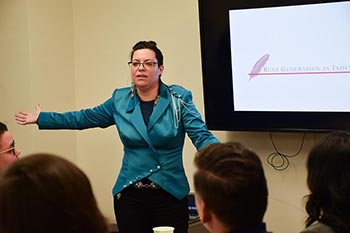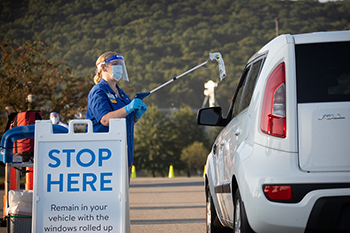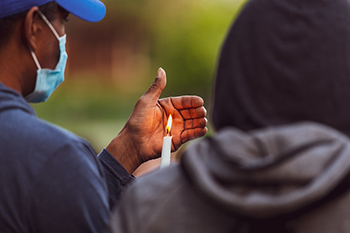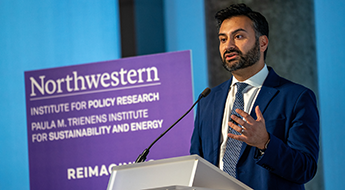2020: A Year Like No Other
IPR’s top content over the year reflects key social themes and the coronavirus pandemic
Get all our news
The problems of 2020 are still with us in 2021, and their effects will be with us for years to come. IPR faculty pivoted to producing relevant research at a record pace over the past year to respond to these crises, and their work remains critically important as our nation continues to confront them.”
Diane Whitmore Schanzenbach
IPR director and economist
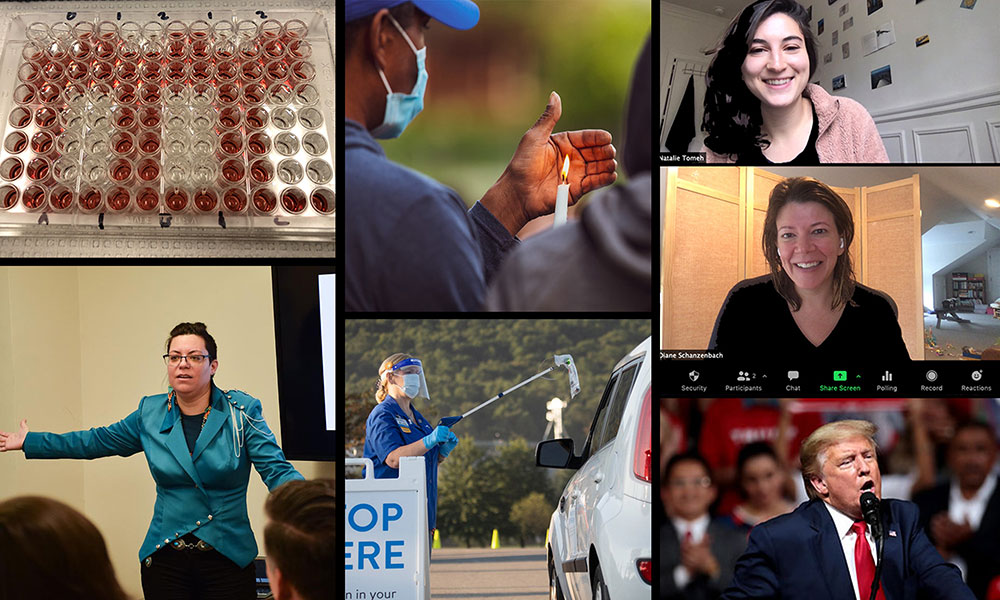
Snapshots from IPR's most-accessed 2020 content (captions below)
2020 was a year in which we saw the unrelenting spread and devastation of the coronavirus, George Floyd’s death and Black Lives Matter protests, a turbulent presidential election amidst entrenched political divisiveness, misinformation and disinformation, growing disparities, deadly gun violence, and a widening recession.
Across IPR’s top content of the year, seven key research themes emerged: food insecurity, poverty, racial disparities, policing and violence, politics, education, and, of course, the pandemic itself.
“The problems of 2020 are still with us in 2021, and their effects will be with us for years to come,” said IPR Director and economist Diane Whitmore Schanzenbach. “IPR faculty pivoted to producing relevant research at a record pace over the past year to respond to these crises, and their work remains critically important as our nation continues to confront them.”
IPR's Top 2020 Content
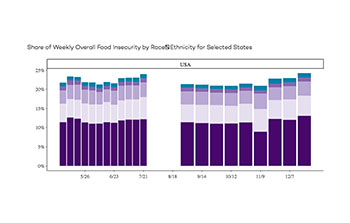
State Levels of Food Insecurity During COVID-19IPR Director and economist Diane Whitmore Schanzenbach has studied food insecurity for most of her academic career, but when some of the first data on food insecurity came through in April after the start of the pandemic, she was shaken. “I’ve never seen numbers this bad,” she said. As one of the nation’s foremost experts on the food safety net, Schanzenbach launched into conducting a real-time study of figures from the COVID Impact Survey and the Census Bureau’s Household Pulse Survey. She and her research assistant Abigail Pitts put together six IPR rapid research reports over the year. She also worked with an undergraduate researcher, Natalie Tomeh, to create an app that allows users to easily access food insecurity rates for each of the 50 states and also to sort by household types as well as racial and ethnic groups. |
|
|
|
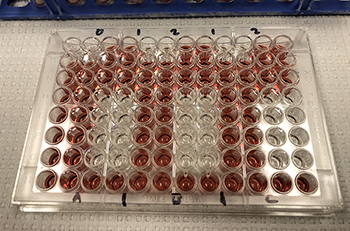
A New Test for SARS-CoV-2 AntibodiesAs antibody testing ramped up across the country in the spring, a team of Northwestern University researchers developed a new method for testing antibodies of SARS-CoV-2, the virus that causes COVID-19. Their method combines the convenience of a single drop of blood collected from a finger stick at home with the analytical rigor of a lab. IPR biological anthropologist Thomas McDade, the paper’s lead author, worked on the interdisciplinary project with Feinberg Medical School faculty Alexis Demonbreun, Richard D’Aquila, and Elizabeth McNally and medical social sciences professor Brian Mustanski, an IPR associate. “[A]ntibody testing is necessary for ascertaining the true prevalence and mortality rate of infection and for evaluating how effective policies such as social distancing or closing schools and restaurants are working to prevent viral transmission,” McDade said. Read the published article here. |
|
|

New Tool Maps Racial Disparity in Arrests Across the CountryAs communities across America gathered to protest police abuses, researchers took a close look at how, where, and why racial disparities in policing occur. IPR sociologist Beth Redbird along with graduate research assistant Kat Albrecht compiled data for a powerful new visual tool that shows how those disparities have grown over time. In their police bias map, Redbird and Albrecht show county by county the extent to which Black Americans are arrested at a higher rate than White Americans—a trend that has only accelerated in recent decades. The tool draws from a recent working paper in which Redbird analyzed data from more than 13,000 law enforcement agencies nationwide. She and Albrecht discovered that even while crime rates fell in recent decades, the racial disparity in arrest rates nearly doubled. For example, in 1999, the average law enforcement agency arrested 5.48 Black Americans to 1 White American, and by 2015 that number had risen to 9.25. Data for the map visualization are available online. |
|
|
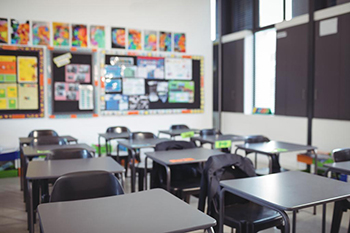
Addressing the Challenges to Educational Research Posed by COVID-19What happens when your research experiment stopped due to the pandemic? IPR statisticians and education policy experts Larry Hedges and Elizabeth Tipton address how to continue with ongoing education research, in particular for randomized field trials in education, the “gold standard” for studies. They identify some possible responses to the disruption, emphasizing those that would allow investigators to capitalize on completed work and sunk investments. They discuss tradeoffs of strategies such as ways to maintain statistical power of designs that could be compromised or dealing with designs that may have lower power than was initially planned. They also consider more radical changes to a study’s initial aims such as focusing on intervention or instrument development, methodological studies, or the codification of craft knowledge. Tipton and Hedges are co-directors of the Statistics for Evidence-Based Policy and Practice, or STEPP, Center at IPR. |
|
|
|
Read more about these and other articles on IPR’s website.
Photo captions and credits:
Top image: (Clockwise from the top left) An assay plate contains samples of reconstituted blood collected from a finger prick that are ready for analysis (courtesy of T. McDade); a vigil in June 2020 for George Floyd and others who have lost their lives to police brutality (Risingthermals, Flickr); screenshot of Diane Schanzenbach and Natalie Tomeh, part of the SURA program; former President Trump at a 2020 election rally (G. Skidmore, Flickr); a woman hands a person a COVID-19 test kit (Pennsylvania Governor's Office, Flickr); Beth Redbird discusses her research on Native American poverty (P. Reese)
Images for articles by rows from left to right: Screenshot of an app tracking food insecurity; Beth Redbird discusses her research on Native American poverty (P. Reese); family isolating due to COVID-19 (iStock); an assay plate contains samples of reconstituted blood collected from a finger prick that are ready for analysis (courtesy of T. McDade); a woman hands a person a COVID-19 test kit (Pennsylvania Governor's Office, Flickr); stock photo of police car (PxHere); a vigil in June 2020 for George Floyd and others who have lost their lives to police brutality (Flickr, Risingthermals); stock photo of classroom; screenshot of Diane Schanzenbach and Natalie Tomeh, part of the SURA program; former President Trump at a 2020 election rally (G. Skidmore, Flickr)
Published: January 26, 2021.
